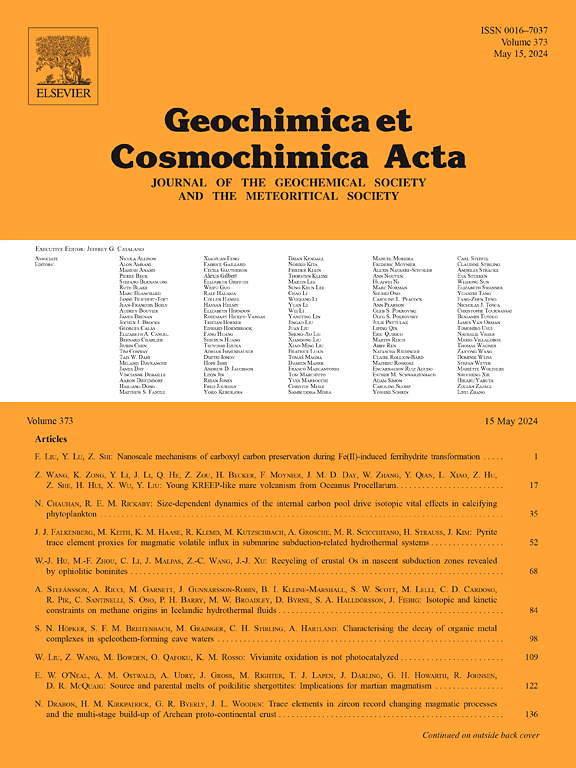Exploring the affinity and selectivity of sedimentary mackinawite (FeS) towards natural organic matter
IF 5
1区 地球科学
Q1 GEOCHEMISTRY & GEOPHYSICS
引用次数: 0
Abstract
While iron oxides have been thoroughly explored in terms of their ability to sorb and sequester organic carbon (OC) in sediments, the role of iron sulfide (Fe-S) minerals in the long-term sequestration of OC remains poorly defined. In this study, we assessed the affinity of different types of natural organic matter (NOM) towards synthetic Fe-S minerals using sorption isotherms. We found affinities and sorption capacities varying in the following order: plankton NOM > corn leaves NOM > aged terrestrial NOM. Scanning electron microscopy showed that NOM increases the size and surface area of Fe-S aggregates, likely also influencing their surface reactivity. High NOM contents in Fe-S minerals protected Fe(II) from oxidation after exposure to atmospheric oxygen. Analysis of the synthetically prepared Fe-S-NOM complexes by synchrotron scanning transmission X-ray microscopy (STXM) coupled to near-edge X-ray absorption fine-edge structure (NEXAFS) spectroscopy revealed strong interactions between Fe-S minerals and NOM extracted from plankton, specifically with amide and carboxylic functional groups. We also attempted to identify and characterize interactions between OC and Fe-S minerals in natural sulfidic sediments from the St. Lawrence Estuary and the Saguenay Fjord, hence linking our work on synthetic iron sulfides to what is occurring in natural environments, although this effort proved more challenging owing to the presence of Fe(III) minerals even at depth and the difficulty in distinguishing FeS from other Fe(II) minerals. We present depth concentration profiles of dissolved OC, iron, and sulfur in the liquid-phase (pore water) along with speciation data from sequential extractions of sulfur in the solid-phase collected from sediment cores. We found a clear association between mixed Fe(II)/Fe(III) minerals and OC in sediments, which, combined with the results of the synthetic FeS experiment, suggests that Fe-S minerals can promote OC sequestration in sediments.
探讨沉积Mackinawite (FeS)对天然有机质的亲和力和选择性
虽然氧化铁在吸收和封存沉积物中有机碳(OC)的能力方面已经得到了深入的研究,但硫化铁(Fe-S)矿物在长期封存OC中的作用仍然不明确。在这项研究中,我们利用吸附等温线评估了不同类型的天然有机质(NOM)对合成Fe-S矿物的亲和力。我们发现亲和和吸附能力的变化顺序如下:浮游生物NOM >;玉米叶NOM >;扫描电镜显示,NOM增加了Fe-S团聚体的尺寸和表面积,可能也影响了它们的表面反应性。Fe- s矿物中高NOM含量保护Fe(II)在暴露于大气氧后不被氧化。利用同步加速器扫描透射x射线显微镜(STXM)和近边x射线吸收精细边缘结构(NEXAFS)对合成的Fe-S-NOM配合物进行分析,发现Fe-S矿物与浮游生物中提取的NOM之间存在很强的相互作用,特别是酰胺和羧基官能团。我们还试图识别和表征来自圣劳伦斯河口和萨格奈峡湾的天然硫化物沉积物中OC和Fe- s矿物之间的相互作用,从而将我们的合成硫化铁研究与自然环境中发生的情况联系起来,尽管由于铁(III)矿物的存在,这项工作被证明更具挑战性,即使在深处也存在铁(III)矿物,并且很难将Fe与其他铁(II)矿物区分开来。我们展示了液相(孔隙水)中溶解OC、铁和硫的深度浓度分布,以及从沉积物岩心中收集的固相硫的顺序提取的物种形成数据。我们发现混合Fe(II)/Fe(III)矿物与沉积物中OC之间存在明显的关联,结合合成FeS实验结果,表明Fe- s矿物能够促进沉积物中OC的固存。
本文章由计算机程序翻译,如有差异,请以英文原文为准。
求助全文
约1分钟内获得全文
求助全文
来源期刊

Geochimica et Cosmochimica Acta
地学-地球化学与地球物理
CiteScore
9.60
自引率
14.00%
发文量
437
审稿时长
6 months
期刊介绍:
Geochimica et Cosmochimica Acta publishes research papers in a wide range of subjects in terrestrial geochemistry, meteoritics, and planetary geochemistry. The scope of the journal includes:
1). Physical chemistry of gases, aqueous solutions, glasses, and crystalline solids
2). Igneous and metamorphic petrology
3). Chemical processes in the atmosphere, hydrosphere, biosphere, and lithosphere of the Earth
4). Organic geochemistry
5). Isotope geochemistry
6). Meteoritics and meteorite impacts
7). Lunar science; and
8). Planetary geochemistry.
 求助内容:
求助内容: 应助结果提醒方式:
应助结果提醒方式:


